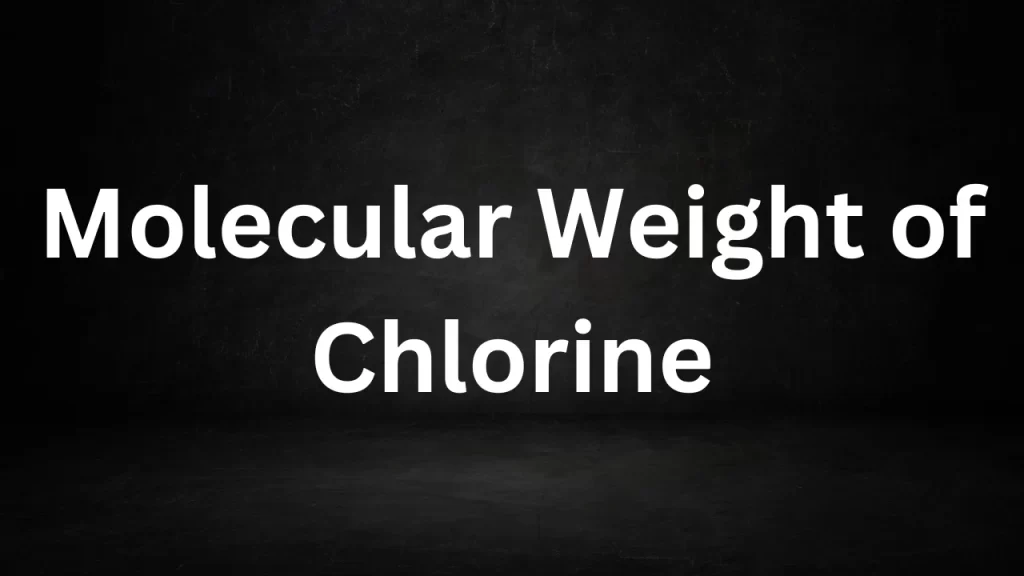Molecular Weight of Chlorine
Molecular Weight of Chlorine: Chlorine is a highly reactive and essential element in the world of chemistry. It plays a crucial role in various chemical processes, from water purification to the production of household chemicals and pharmaceuticals.
One of the fundamental characteristics of any chemical substance is its molecular weight, a property that holds significant importance in understanding and working with chlorine. In this article, we will explore the concept of molecular weight and its relevance in the context of chlorine.

Molecular Weight of Chlorine
The Nature of Chlorine
Before delving into the molecular weight of chlorine, it is important to understand the nature of this element. Chlorine, denoted by the chemical symbol Cl, is a halogen found in group 17 (formerly group VIIA) of the periodic table. It exists primarily as a diatomic molecule, Cl2, composed of two chlorine atoms bonded together. This diatomic form is the most common and stable form of chlorine.
Importance of Molecular Weight
Molecular weight, also known as molar mass, is the mass of a molecule or compound expressed in atomic mass units (amu) or grams per mole (g/mol). It is a fundamental property in chemistry and plays a pivotal role in various aspects of chemical science and industry, including:
- Stoichiometry: Molecular weight is essential for determining the stoichiometry of chemical reactions, helping chemists balance equations and calculate reaction yields.
- Synthesis: Chemists use molecular weight to measure and combine reactants accurately when synthesizing compounds or formulating solutions.
- Analytical Chemistry: Molecular weight is crucial in identifying and quantifying compounds through techniques like mass spectrometry.
- Physical Properties: Mol weight influences a substance’s physical properties, such as melting point, boiling point, density, and solubility.
Calculating the Mol Weight of Chlorine
To calculate the mol weight of chlorine (Cl2), you need to consider the atomic mass of a single chlorine atom. The atomic mass of chlorine is approximately 35.45 atomic mass units (amu).
Now, let’s calculate the mol weight of chlorine (Cl2):
Mol Weight of Chlorine (Cl2) = (2 × Atomic Mass of Chlorine) Molecular Weight of Chlorine (Cl2) = (2 × 35.45 amu) Molecular Weight of Chlorine (Cl2) = 70.90 amu
The mol weight of chlorine (Cl2) is approximately 70.90 amu.
Implications of Chlorine’s Molecular Weight
The molecular weight of chlorine, approximately 70.90 amu, holds several implications in the field of chemistry and industry:
- Quantitative Analysis: In analytical chemistry, chlorine’s molecular weight is crucial for accurately determining its concentration in samples, such as in water quality testing.
- Chemical Reactions: Chlorine’s mol weight is essential for stoichiometric calculations in chemical reactions involving chlorine gas, ensuring precise measurements and predictions.
- Safety: Understanding the mol weight of chlorine is important in handling and storage to prevent accidents since chlorine gas is toxic and can be hazardous when mishandled.
- Industrial Applications: Chlorine’s mol weight is a key parameter in industries using chlorine for various processes, including the production of chemicals, plastics, and pharmaceuticals.
Conclusion
- The molecular weight of chlorine, approximately 70.90 amu for the diatomic molecule Cl2, is a fundamental property that plays a pivotal role in chemistry and industry. It is crucial for stoichiometric calculations, precise measurements, and the understanding of chlorine’s physical and chemical properties. As an element of great significance in various applications, chlorine’s molecular weight continues to be a critical parameter for chemists and professionals working with this versatile and essential element.
Read More
- Molecular Weight Of Benzene
- Lumen Meaning In Biology
- Molecular Weight Of Sucrose
- Molecular Mass Of Carbon
- Molar Mass Of Phosphorus
Frequently Asked Questions (FAQs) Molecular Weight of Chlorine
Q1: What is molecular weight, and why is it important in chemistry?
A1: Mol weight, also known as molar mass, is the mass of a molecule or compound expressed in atomic mass units (amu) or grams per mole (g/mol). It is important in chemistry for various reasons. It including stoichiometry, determining reactant and product quantities in chemical reactions, and understanding physical properties of substances.
Q2: What is the chemical symbol for chlorine, and what is its common form?
A2: The chemical symbol for chlorine is Cl. Its common form is the diatomic molecule Cl2, where two chlorine atoms are bonded together.
Q3: How is the mol weight of chlorine (Cl2) calculated?
A3: To calculate the mol weight of chlorine (Cl2), you sum the atomic mass of a single chlorine atom, which is approximately 35.45 atomic mass units (amu). Then multiply by 2 (since there are two chlorine atoms in Cl2).
Q4: What is the mol weight of chlorine (Cl2)?
A4: The mol weight of chlorine (Cl2) is approximately 70.90 amu (atomic mass units).
Q5: Why is the mol weight of chlorine important in water treatment?
A5: Chlorine is commonly used in water treatment to disinfect and purify drinking water. Its mol weight is important because it helps in accurately measuring the amount of chlorine needed to effectively treat water. It also ensure water safety for consumption.